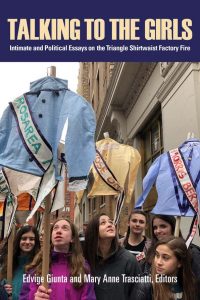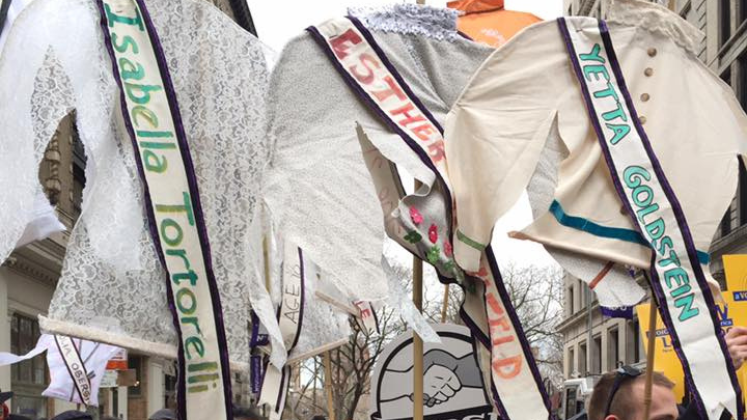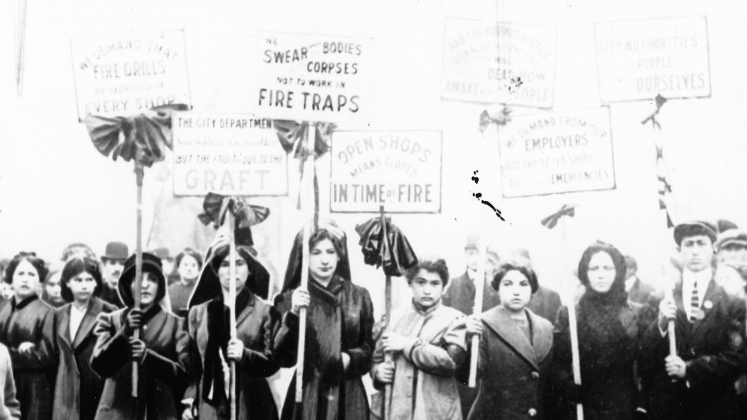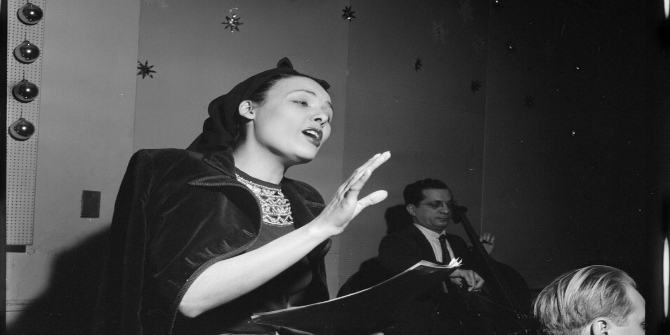Edvige Giunta introduces her new volume, Talking to the Girls, co-edited with Mary Anne Trasciatti, which remembers the Triangle Shirtwaist Factory Fire of 1911, which killed 146 workers in a labour force of predominantly Eastern European Jewish and Southern Italian women immigrants. The book uses intimate and political storytelling to recover memories of the Triangle fire and explore the solidarities the fire forged in shaping workers’ rights and unions.
Remembering the Triangle Fire through Intimate and Political Storytelling
 In the 1970s, feminists marched on the streets of Italy chanting a song about women who had died in a factory fire. ‘Ricordatevi di noi,’ the song went: ‘Remember us’ — the women who protested, who went on strike, who were killed by capitalist greed. The history of a factory fire that had occurred in New York City at the beginning of the twentieth century thus made its way into Italian feminist memory.
In the 1970s, feminists marched on the streets of Italy chanting a song about women who had died in a factory fire. ‘Ricordatevi di noi,’ the song went: ‘Remember us’ — the women who protested, who went on strike, who were killed by capitalist greed. The history of a factory fire that had occurred in New York City at the beginning of the twentieth century thus made its way into Italian feminist memory.
Yet many details were missing or misremembered. For example, there was no mention of the name of the factory, the number of the dead or the origins of the workers (most of them were Eastern European Jewish and Southern Italian immigrants). The fire that killed 146 workers at the Triangle Waist Company, better known as the Triangle Shirtwaist Factory, happened on 25 March 1911 — not on 8 March — and International Women’s Day was not established to commemorate the anniversary of the fire.
Yet, the Italian feminist memory of the fire was animated by the same passion for social justice and gender equality that was central to the fire’s history. The Triangle fire — which happened after the New York City 1909 strike of garment workers known as the ‘Uprising of the 20,000’ — changed US social history. Its memory and the solidarity it inspired have reverberated across time — over a century — and space — from the United States to Italy to Bangladesh. 2023 will mark the inauguration of the Triangle Fire Memorial, the first labour monument and one of the few monuments devoted to women in New York City. The names of the 146 workers killed are being cast on the monument constructed at the site of the fire, while at the yearly commemoration participants hold high 146 shirtwaist kites, each bearing the name of a worker.

Photo courtesy of Edvige Giunta
In the 1970s, I was a young Sicilian feminist who did not know that many of the Triangle workers were my fellow Sicilian women. I did not know that the youngest worker who died in the fire was 14-year-old Rosaria Maltese, from Marsala, a town about 130 miles from Gela, my hometown, where I started to heed the call to remember the Triangle workers. While my first encounter with the fire lacked historical precision and accuracy, it became a foundational moment of remembrance that shaped my budding feminism.
Decades later, it would lead me to develop a course on the Triangle fire at New Jersey City University in Jersey City, a few miles from where the fire occurred. In 2001, the memory of the fire would spur me to organise, with the Collective of Italian American women and Casa Italiana at New York University, a 90th commemoration of the fire, which was also the first public Italian American commemoration of this event. Every 25 March, I remember 17-year-old Isabella Tortorelli, the Triangle worker whose name I called at the 90th commemoration at the Brown Building, once the site of the factory.
It was the memory of Isabella, Rosaria, Clotilde, Rosie, Margaret, Sarah and all the other Triangle workers, and the ethical urge not to forget them, that led me to edit the first anthology of essays on the fire, with Mary Anne Trasciatti, President of the Remember the Triangle Fire Coalition, the organisation that has led the initiative to build the Triangle Fire Memorial. Talking to the Girls: Intimate and Political Essays on the Triangle Shirtwaist Factory Fire was published by New Village Press in 2022.
The grief and indignation that followed the Triangle fire sustained a social and political movement that demanded immediate action to remedy the dismal conditions of workers in the US at the turn of the 20th century. The New York Factory Investigating Commission launched a wide and unprecedented investigation into worker safety that resulted in key legislative changes. Among those who advocated for safety in the workplace was Frances Perkins, who witnessed the fire and was forever changed by it. Her undaunted commitment to the wellbeing of workers is best evidenced by the historic changes she effected when President Franklin D. Roosevelt appointed her US Secretary of Labor in 1933. In his essay for Talking to the Girls, Tomlin Coggeshall, Perkins’s grandson, tells us of the woman who witnessed the fire and became the first woman to join a US Presidential cabinet, but he also tells us of the woman he knew as his grandmother.

Image Credit: Crop of ‘Mourners picket after the Triangle fire. Their signs, hung with black crepe, accuse shop owners of graft, locked doors, and managing workers in fire traps’ licensed by The Kheel Center for Labor-Management Documentation and Archives under CC BY 2.0
Talking to the Girls is not a book about the fire or its causes and place in history, though these issues are variously addressed in both the introduction and the essays. Instead, Talking to the Girls explores the question of the layered memory work that has grown out of this historic event, its permutations and representations, and the many forms of creative intellectual, pedagogical and political work it has inspired.
We asked the authors to tell us their Triangle story. How had they first learned about the fire? How had the fire shaped their lives and work? How did they remember the fire? What is its contemporary relevance? A delicate and visceral interweaving of the intimate and the political permeates each of the 17 essays in the book and the interview with Bangladeshi garment union leader Kalpona Akter, who says that ‘The Triangle fire changed the whole labor movement.’
Talking to the Girls highlights the ways in which the Triangle fire still speaks to us, and how we must listen and respond. The displacement of artists and communities caused by gentrification in New York City (Annie Lanzillotto); the Chinese American garment workers’ strike of 1982 and the vital role of the union (May Chen); what Triangle can teach us in the age of global capitalism, when we have all become ‘fast-food workers’ (Annelise Orleck); young activists, from International Ladies’ Garment Workers’ Union (ILGWU) organiser Clara Lemlich to March for Our Lives leaders X González and Naomi Wadler (Jacqueline Ellis); the absence of Black women workers in the early-twentieth-century garment industry as a result of racism (Janette Gayle); and the connections between the refugees of yesterday and those of today (Ellen Garvey) — these are some of the topics the essays explore while connecting them with personal experiences.
In telling the stories that bound the authors to the history of the Triangle fire — as family members of Triangle workers or witnesses to the fire, as activists, teachers, artists, writers and scholars—the essays coalesce into one multi-voiced narrative. The voices are bold, lyrical, mournful, urgent, hopeful. Talking to the Girls offers a model for how to speak of history — and how to speak to history — in a manner that is intimately connected to the fabric of our daily lives.
Talking to the Girls: Intimate and Political Essays on the Triangle Shirtwaist Factory Fire, edited by Edvige Giunta and Mary Anne Trasciatti, is out now with New Village Press. Thank you to Edvige Giunta for providing a photo for use in the piece.
Banner image credit: Image Credit: ‘Mourners from the Ladies Waist and Dressmakers Union Local 25 and the United Hebrew Trades of New York march in the streets after the Triangle fire’, 1911 (photo ID 5780PB39F17DP400G licensed by The Kheel Center for Labor-Management Documentation and Archives under CC BY 2.0.
- This article first appeared at LSE Review of Books.
- Please read our comments policy before commenting.
- Note: This article gives the views of the author, and not the position of USAPP – American Politics and Policy, nor of the London School of Economics.
- Shortened URL for this post: https://bit.ly/3NG7fww






